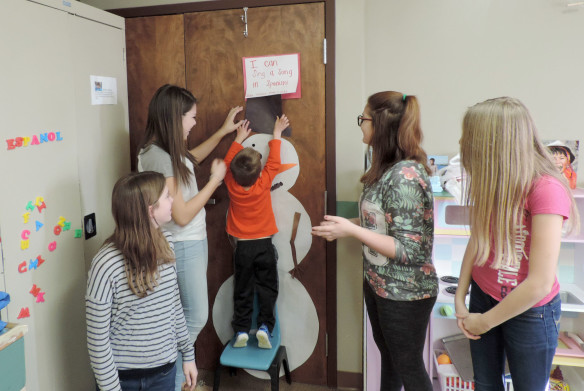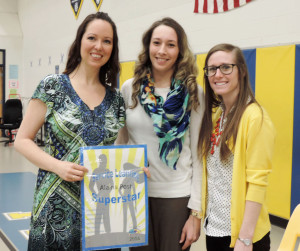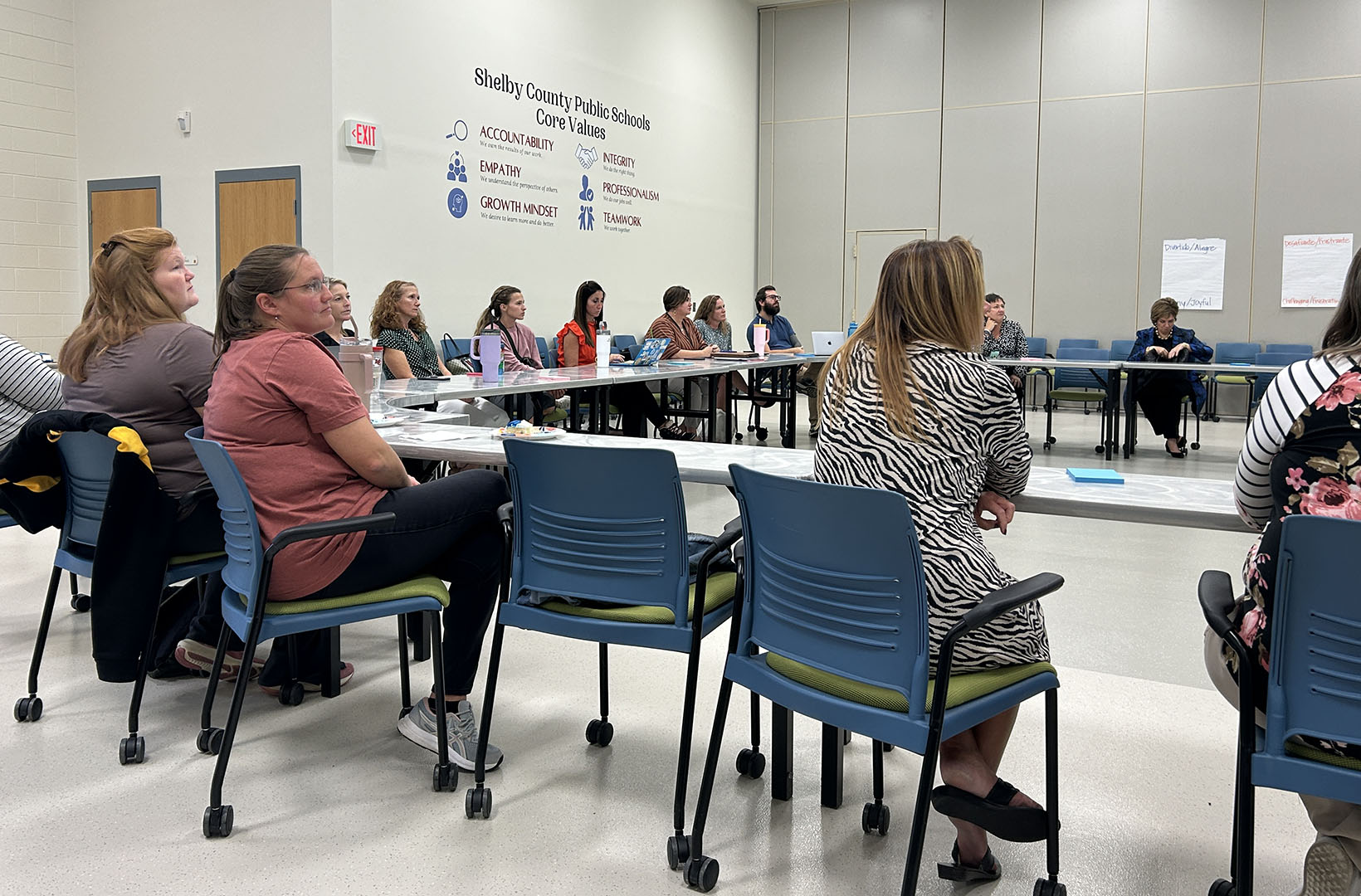
Camp Ernst Middle School students, from left, Emily Chaney, Sarah Willman, Leinda McNabb and Alyssa Land teach daycare students how to sing “Frosty the Snowman” in Spanish.
Photo by Paige Holmes
By Alaina Post
alaina.post@boone.kyschools.us
Last May, Basic Trust Child Development Center in Alexandria, Ky., contacted me about Spanish immersion at their school. While advising them, I had an idea – maybe I could utilize my students to help their school.
Since 2003, I have taught Spanish to students of all ages in settings ranging from elementary to traditional high school classes and from college beginner courses to even students in immersion schools. In Boone County, I was given the challenge of building a program and within three years, was asked to teach a Spanish I class at the 8th-grade level. I knew that using my students to help the preschool would enhance students’ learning by teaching others, but I had not yet figured out how to execute the idea.

Boone County Spanish teacher Alaina Post, from left, Boone County Service Learning Coordinator Paige Holmes and preschool teacher Jessica Courter celebrate Post’s being recognized by Children, Inc., for a service-learning project. Post’s students taught Spanish to the children at the preschool where Courter teachers.
Photo by Stephanie Hagerty
In August, I found out through my principal that Camp Ernst Middle School had received funding for service learning projects and suddenly, my plan fell into place. I informed my two Spanish I classes of the preschool’s dilemma: they wanted Spanish immersion but had no one to teach it. I asked what we could do and the students immediately began coming up with ideas. After deciding that we would do a two-day field trip, one with each class, the students formed groups, brainstormed ideas to teach, and began coming up with their learning targets and lists of needed materials.
As a service learning project requirement, students wrote reflections on their learning at various stages. Before the project, some students had taught in the form of tutoring or guiding Sunday school lessons, but most had no experience in teaching nor had they ever considered the idea. Several concepts of teaching had to be figured out as they planned their lessons. For example, teaching students ages 3 to 6 is very different from teaching middle schoolers. In planning their lessons, I overheard several students asking themselves and each other if they thought the preschoolers would be able to perform their learning target and/or how they would get the results they were looking for with students of that age group.
In order to truly facilitate world language learning, I introduced my students to the world language standards and taught them how to write lesson plans, which included interpretive, interpersonal and presentational activities in the target language. Each group of students had to put together a portfolio to take on the field trip with them. These included their lesson plans, materials and in some cases, a script of what they planned to say in Spanish to keep them on track. Many of the groups had even thought their lesson through to a candy reward for completing their learning target and had asked me to check if any students at the preschool had allergies.
As the field trip dates neared, I called on my colleagues to bring in their own preschool-aged children as “guinea pigs” for the project. For the Spanish I students, trying out their lessons on 0real preschoolers was a wake-up call.
“Practicing on the children of teachers in our own school taught us that it was necessary to over-plan and be as prepared as possible,” said 8th-grader Elisabeth Bautista, “We wanted to keep the students engaged at all times in order to reach their maximum learning potential. We did this in a lot of ways and used different teaching techniques. This caused us to change our original lesson slightly so that when it came for the real deal, we knew exactly what to do.”
On the day of the field trip, I could sense the excitement and nervousness of the students. A group of boys to my right were double-checking their Spanish pronunciation of the words they planned to teach about their musical instruments, and I could overhear others going through their lesson plan procedures with their groupmates.
Once we arrived, I supervised the students setting up their stations on the miniature tables and chairs. When the preschool students arrived, my 8th-graders sprang into action and I could hear their Spanish songs, chants and directions. The preschoolers started off shy, but then hit their groove by the second station, asking their teachers what Spanish they were going to learn and if they were going to earn any candy. Both field trips went off without a hitch and we were soon back in our classroom reflecting on the service learning project.
“To help preschoolers expand their Spanish vocabulary was truly amazing,” 8th-grader Charlotte Shores said. “For the students who did not feel inclined to participate in our demonstration, they eventually did in the end once their friends were excitedly shouting out Spanish words. If I had the chance to teach them again, I would do it without a doubt.”
A month after the service learning project, I received an email from Paige Holmes, our district’s service learning coordinator. She informed me of the Jefferson Awards Foundation and said my students’ project should be nominated to win one of the local awards for outstanding service learning project of the month. The Jefferson Awards Foundation is the country’s longest-standing organization dedicated to activating and celebrating public service. The organization works with several local and national partners to recognize outstanding individuals or groups who provide services that impact their communities.
Holmes said the project my students accomplished aligned perfectly with the Jefferson Award’s purpose of being “a call to action” for youngsters, and she wrote the winning nomination for us! The awards ceremony was held on March 3 in our school’s gymnasium and the students were noticeably proud to be recognized for their outstanding service to the community.
Alaina Post teaches Spanish at Camp Ernst Middle School (Boone County). She has a bachelor’s degree in Spanish from Wright State University, a master’s in Hispanic studies and a master’s in teaching world languages from the University of Kentucky.



Leave A Comment